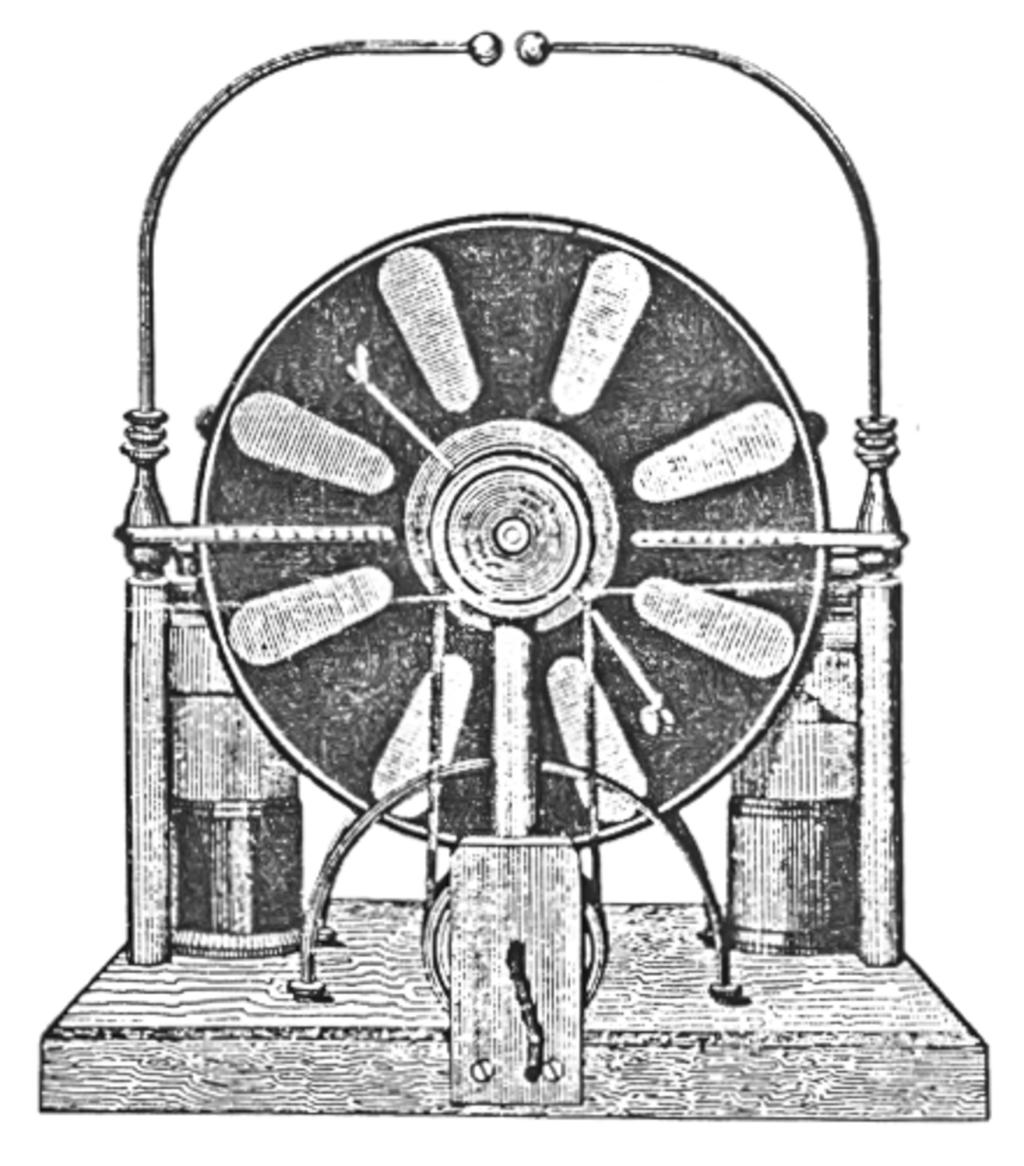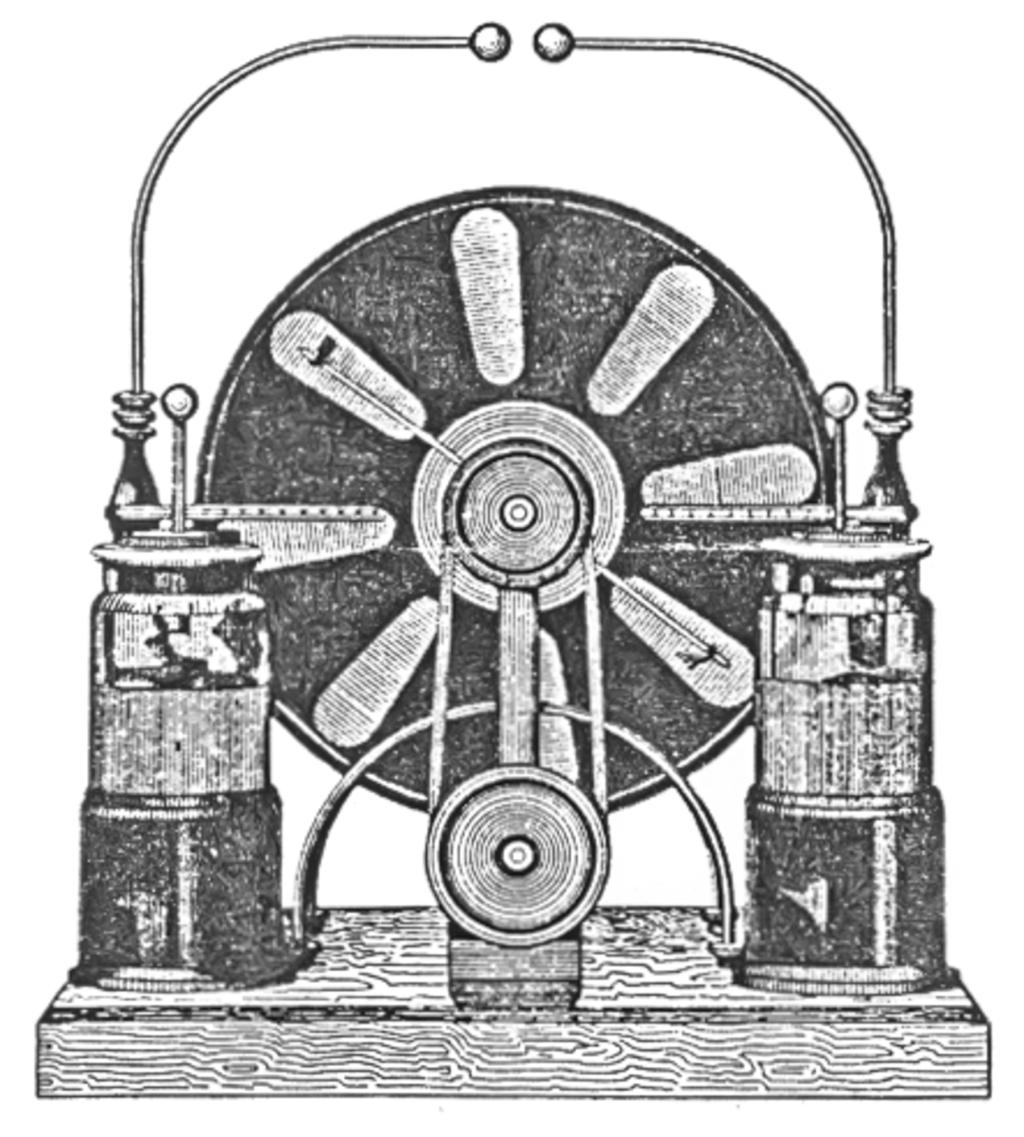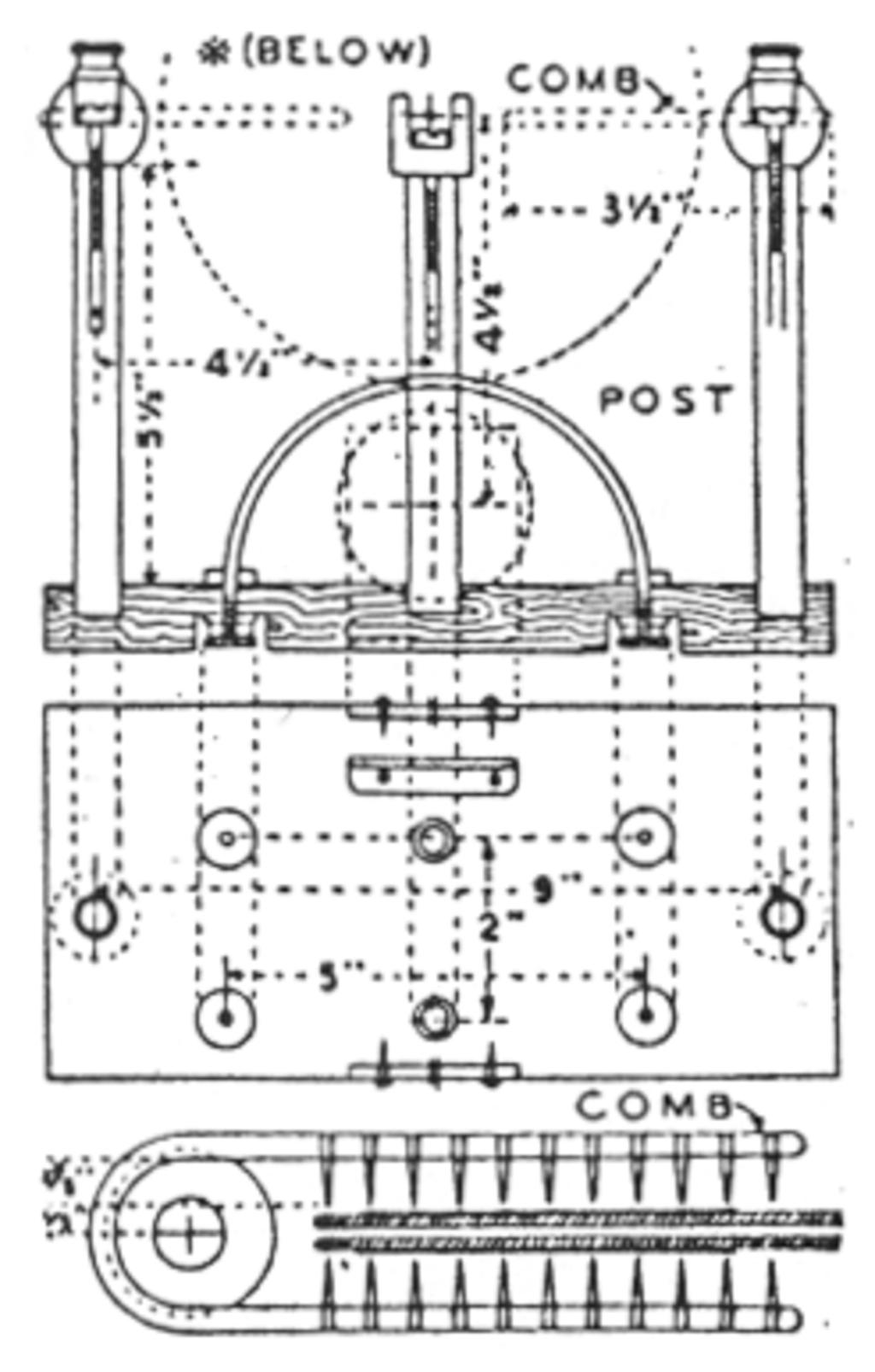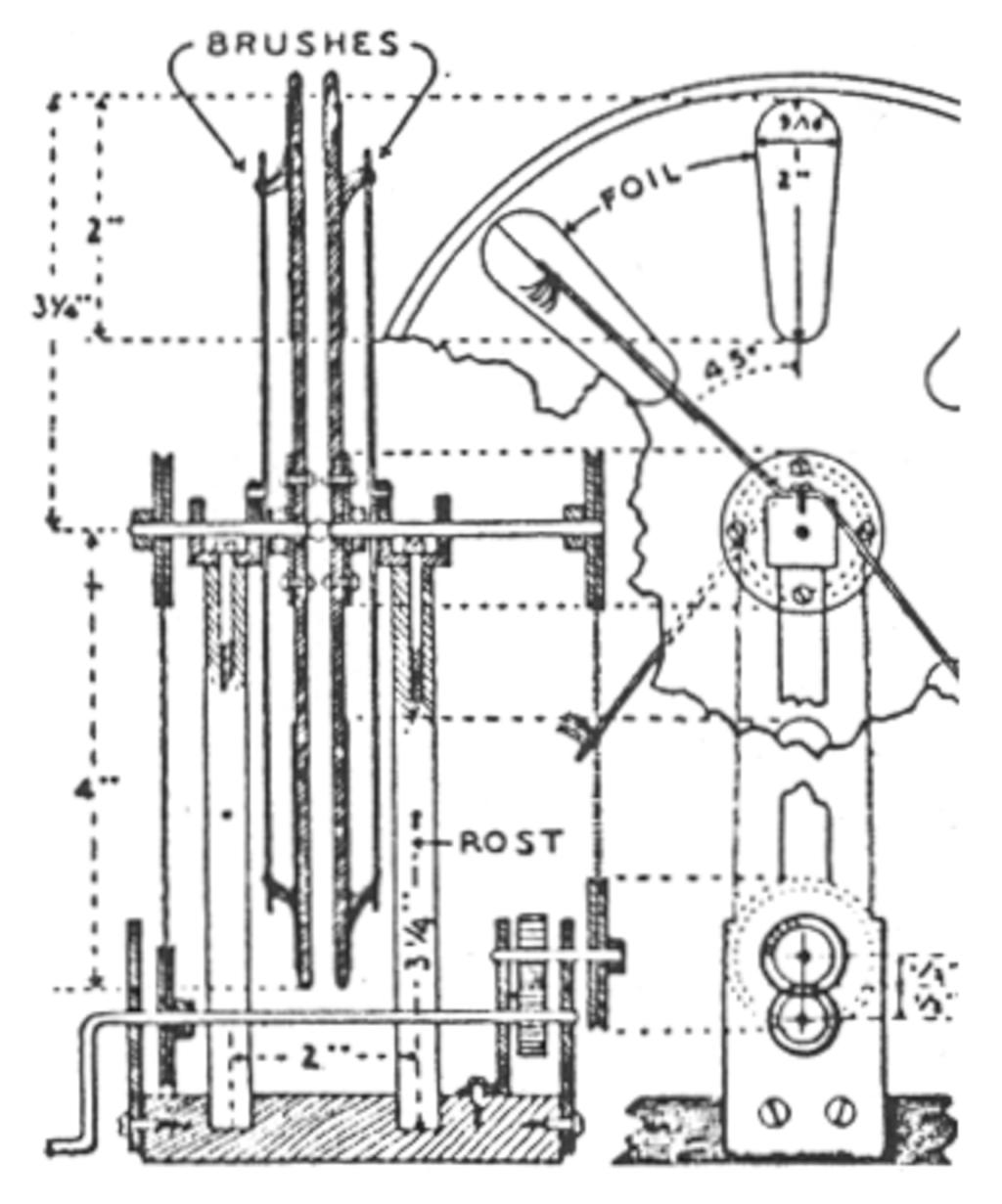TCBA Volume 6 - Issue 1
Page 6 of 18
Static Machine from Scraps
40,000-Volt Wimshurst Machine Easily Made
• A WIMSHURST machine, as shown in Figs. 1 and 2, is simply a mechanical device for rotating in opposite directions two sets of metallic conductors - in this case sectors of tinfoil shellacked to 8" phonograph records - with appropriate apparatus for collecting the electric charges induced on them.
The essential parts of the machine must be perfectly insulated; for which reason they are usually mounted on glass pillars. In this model, vulcanite, hard rubber, or some such composition is used; it must be remembered that dry wood is not a good insulator to high-potential static electricity.
The vulcanite “posts” are 6" radio lead-in tubes. The brass rods and terminals, which are first removed, come in for use in other parts of the machine. The base is a block of 1" oak, and the posts are mounted on it in the following way: holes slightly larger in diameter than the posts are bored half-way through the wood. Some flowers of sulphur are then melted in a tin over a gas jet, and the liquid is poured into one of the holes. The post is stuck in, squared up, and held until the sulphur cools. Posts mounted in this way are surprisingly firm. (Fig. 3)
To strengthen the middle posts, which carry the bearings of the plate spindles, a hole is drilled through each, about half-way up; and a brass rod from a lead-in tube is pushed through and bent in a semi-circle. The two ends, which are threaded, are then bolted down to the base in the manner shown.
The bearings and collecting combs can be attached to the tops of the posts by tight-fitting screws, which will cut their own threads in the vulcanite. The collecting combs themselves are made from lengths of brass rod bent into a U. A convenient number of small holes are drilled through each arm of the U, and phonograph needles, broken off to a suitable length, are soldered in. The ends of the rods should be carefully rounded; as it is essential in electrostatic machines to have all metal parts smooth and polished, and to avoid all sharp corners. However, since all electric charges are carried on the surface, it does not matter whether the parts are hollow or solid.
The combs are then so mounted that the plates can revolve between them without quite touching them. The clearance may be as much as a fifth of an inch without any serious loss of electrical charge.
Eight strips of tinfoil are shellacked at equal distances, on one aide only of each phonograph record; and a wheel with a setscrew is bolted to the centre to facilitate attachment to the spindles. The records are then mounted to rotate back to back, the foil strips facing the points of the combs. To keep the records apart, a ball-bearing is slipped in between the two spindles; which also makes for smooth running, since the spindles rotate in opposite directions.
On the tops of the brass knobs, to which the combs are attached, the terminals from a lead-in tube are soldered. Two of the brass knobs can then be bent into semi-circles and screwed in to form the “conductor arms.” These terminate in two brass balls (between which the sparks are produced), at the top of the machine. It is as well to use smooth rods, to avoid the sharp edges which occur inevitably if they are threaded throughout their length. Brass bedpost knobs are attached, by filling them with metal cement, and then pushing the rods in. Alternatively, large bright ball bearings could be soldered on.
The pulleys must be so chosen that the two plates rotate at the same rate. The brushes are made from short tufts of wire taken from a piece of “flex” electric lighting wire. One brush is soldered to each end of a piece of brass wire about 7" long, and the wire mounted on a spindle bearing, as shown in Fig. 4. (This assures its being well grounded.) The two arms of the wire are so bent as to make an angle of 45 degrees with the vertical, and the brushes adjusted so that they ground a foil on opposite edges of the plate simultaneously. The brushes on the other plate are set at right angles to these, and ground their foils at the same time.
If the whole instrument is brightly polished and perfectly dry, on turning the handle, slowly, a “sizzling” sound will be heard. This is due to internal discharges in the machine, visible as a blue glow, with sparks, if performed in the dark. On turning a little faster, sparks up to 1/2" in length will jump between the brass knobs at the top of the machine.
If you get no results at the first attempt, see that the brass knobs are not touching, and then rub a vulcanite rod briskly on your sleeve to electrify it. Hold it to one of the combs while turning the handle, and the machine will soon charge up and function normally. Sparks produced in this way, without the use of Leyden jars, can be taken on the finger or knuckle without harm or appreciable shock, though the voltage for a half-inch spark in dry air is 30,000!
An increased effect is produced by connecting a couple of condensers to the terminals. These are capable of accumulating the charges of electricity until they are full, and then discharging them suddenly in a violent blue spark. (This should on no account be taken through any part of the body, or a severe shock will be felt.)
The type of condenser usually employed is the Leyden jar, shown in Fig. 1. It is quite easy to make one from a preserve jar, as follows: Wash and dry the jar thoroughly, and line it with tin foil to about three-quarters of the way up inside. The easiest way to do this is to cut up several small strips of tinfoil and stick them in with shellac, one at a time, so that they overlap one another. Then the outside of the jar is coated to the same level, in the same way. The cork, or vulcanite stopper, carries a short brass rod with a ball on its upper end. The lower end must make some sort of metallic contact with the inner coat of foil, the simplest way being by means of a short chain.
When two of these jars have been made, connect the brass rods or balls with the two terminals, or the comb-bearers, of the machine; and either ground their outer coats, or connect them together by standing both jars on the same strip of metal. The machine will now produce the large sparks at about one-second intervals; the size (but not the length) of the sparks, and the interval, depending on the capacity of the Leyden jars used. - Practical Mechanics.
Warning!
American experimenters, when constructing static machines, usually meet with failure in that they cannot get the machines to operate. The reason for this is found in the American glass used in the Leyden jars. This is usually of the lead glass variety. It is absolutely no good for static machines as such glass does not hold the charge in as much as it is conductive to the high frequency static discharge. You must use potash glass, or the variety known as Pyrex. Ordinary test tubes and chemical glassware made in this country is all of the lead glass variety and cannot be used.
* A special thanks to Jim Berger of Tiffin Ohio, for sending this in.




